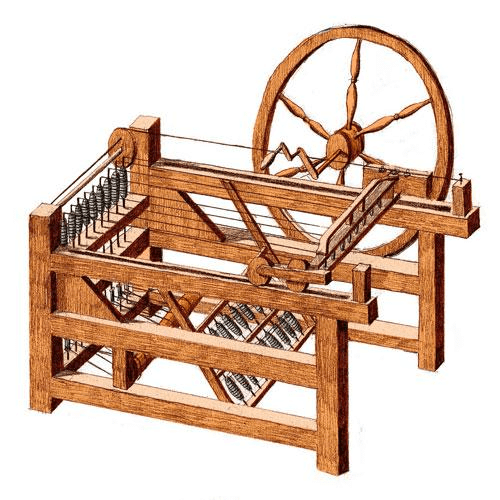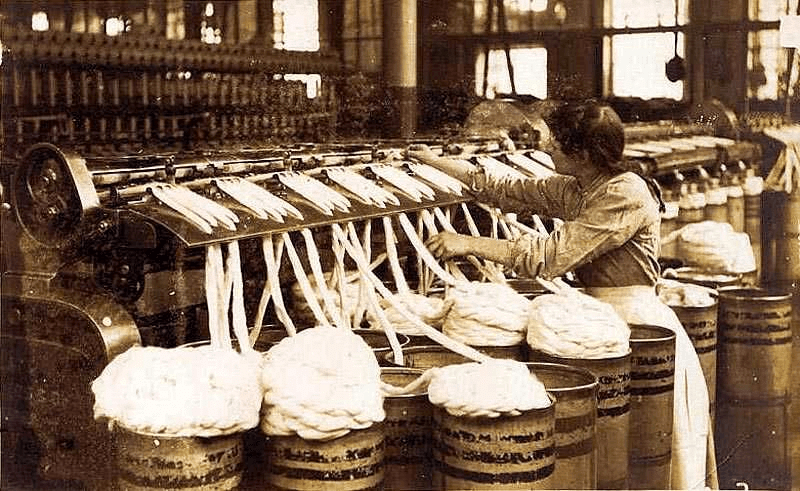NCERT Solutions for Class 10 History Chapter 4 - Age of Industrialisation
Q1. Explain the following:
(a) Women workers in Britain attacked the Spinning Jenny.
 Spinning JennyAns:
Spinning JennyAns:
- With the Spinning Jenny, only one worker was enough to set a number of spindles in motion by turning one single wheel and could spin several threads at the same time, speeding up the spinning process.
- Women workers in Britain had survived on hand spinning. The new machine caused a valid fear of unemployment among women working in the woollen industry.
(b) In the seventeenth century merchants from towns in Europe began employing peasants and artisans within the villages.
Ans:
- The demand for goods increased with the expansion of world trade. The town producers failed to produce the required quantity.
- The trade and commerce guilds were very powerful. They controlled the market, raw materials, employees, and also the production of goods in the towns. This created problem for merchants who wanted to increase production by employing more men.
- The rulers granted different guilds the monopoly right to produce and trade in specific products. It was therefore difficult for new merchants to set up business in towns. So they turned to the countryside and began employing peasants and artisans within the villages.
(c) The port of Surat declined by the end of the eighteenth century.
Ans:
- The European companies gradually gained power, securing a variety of concessions from local courts and monopoly rights over trade. With the growth of colonial power, the ports of Bombay and Calcutta grew.
- Trade started through new ports controlled by European companies and was carried in European ships.
- The above factors resulted in a decline of the old ports such as Surat. In the last years of the seventeenth century, the gross value of trade that passed through Surat fell from ₹16 million to ₹3 million by 1740.
(d) The East India Company appointed gomasthas to supervise weavers in India.
Ans:
- After establishing political power, the East India Company could assert over monopoly Indian trade. So it took various steps to eliminate competition, control costs and ensure supplies of cotton and silk goods.
- One of the steps was to appoint a paid servant called the gomastha to supervise weavers, collect supplies and examine the quality of cloth.
- The weavers who had taken advances from the Company had to hand over the cloth they produced to the gomastha.
- However, the gomasthas were outsiders with no long-term social link with the village. They acted arrogantly and punished weavers for delays.
Q2. Write True or False against each statement:
(a) At the end of the nineteenth century, 80 per cent of the total workforce in Europe was employed in the technologically advanced industrial sector.
Ans. False
At the end of the nineteenth century, less than 20 per cent of the total workforce was employed in technologically advanced industrial sectors
(b) The international market for fine textiles was dominated by India till the eighteenth century.
Ans. True
Before the age of machine industries, silk and cotton goods from India dominated the international market in textiles. By the late eighteenth century, however, the situation changed with the arrival of East India Company.
(c) The American Civil War resulted in the reduction of cotton exports from India.
Ans. False
When the American Civil War began, cotton supplies from the United States were disrupted, prompting Britain to look to India for its cotton needs. As a result, India's raw cotton exports surged.
(d) The introduction of the fly shuttle enabled handloom workers to improve their productivity.
Ans. True
The fly shuttle is a mechanical device for weaving that uses ropes and pulleys to insert horizontal threads (weft) into vertical threads (warp). Its invention enabled weavers to use large looms and produce wider cloth.
Q3. Explain what is meant by proto-industrialization.
Ans:
- The early phase of industrialisation in which large-scale production was carried out for the international market was known as proto-industrialisation. This type of industrialization was not based on the factory system but on decentralised units.
- During this period, most of the goods were hand manufactured by trained crafts-persons for the international market.
Q4. Why did some industrialists in nineteenth-century Europe prefer hand labour over machines?
Ans: In the 19th century, Europe some British industrialists preferred hand labour over machines because:
- New technologies and machines were expensive and untested. So the producers and the industrialists were cautious about using them.
- Machines often broke down and repairing them was an expensive affair.
- Poor peasants and migrants moved to cities in large numbers in search of jobs. As a result, there was a large pool of labourers available for cheap labour.
- In seasonal industries, where production fluctuated with the seasons, industrialists usually preferred hand labour, employing workers only for the season, when it was needed.
- The variety of products required in the market could not be produced by the machines available at that time. In the mid-nineteenth century, in Britain, for instance, 500 varieties of hammers and 45 kinds of axes were produced. These required human skills and not mechanical technology.
Q5. How did the East India Company procure regular supplies of cotton and silk textiles from Indian weavers?
Ans: The East India Company adopted various steps to ensure regular supplies of cotton and silk textiles:
- They established political power to assert a monopoly on the right to trade.
- The company tried to eliminate the existing traders and brokers connected with the cloth trade and establish direct control over the weavers. It appointed paid servants called the ‘Gomasthas’, to supervise weavers, collect supplies and examine the quality of cloth.
- It prevented the company weavers from dealing with other buyers. Once an order was placed, the weavers were given loans to purchase the raw material. Those who took loans had to hand over the cloth they produced to the Gomasthas only. They could not take it to any other trader.
- They developed a system of management and control that would eliminate competition, control cost and ensure a regular supply of cotton and silk goods. This system forced the sale at a price dictated by the company. By giving the weavers a loan, the company tied the weavers with them.
Q6. Imagine that you have been asked to write an article for an encyclopedia on Britain and the history of cotton. Write your piece using information from the entire chapter.
Ans: During the 17th and 18th centuries, there was a trade-in textile production among the merchants and the rural people. A garment maker would buy wool from a wool stapler, then it would be taken to the spinners, and later to the yarn weavers, and for the final product, it would be taken to fuller and dyers. The finishing centre for the goods was London. This phase in British manufacturing history is known as proto-industrialisation. In this phase, the factories were only a network of commercial exchange and not an essential part of the industry.  Cotton industry
Cotton industry
Cotton came up as the first symbol of the new era of factories. During the late 19th century, its production increased rapidly. Imports of raw cotton sky-rocketed from 2.5 million pounds in 1760 to 22 million pounds in 1787. The reason behind this was the invention of the cotton mill and new machines and better management.
One of the new inventions during that time was the Spinning Jenny. Most inventions in the textile production sector were met with disregard and hatred by the workers because machines implied less hand labour and lower employment needs. Before such inventions, cotton and silk goods were imported from India in vast numbers. There was a high demand for fine textiles of India in England. After the East India Company gained political power, they exploited the weavers and textile industry in India to its fuller potential. Manchester became the hub of cotton production. Consequently, India turned into a major buyer of British cotton goods.
During the First World War, the British were in a rush to provide for war needs. Hence, the demand for Indian textiles rose again. There was a fluctuation in the demand and supply in textile production.
Q7. Why did industrial production in India increase during the First World War?
Ans: There was an increase in industrial production during the First World War in India due to the following reasons:
- British industries became busy producing and supplying the war essentials. Hence, they stopped exporting British goods or clothes for colonial markets like that in India.
- With the decline of imports suddenly, it was a good opportunity for Indian industries to produce enough goods to meet the demand of the home market.
- As the war prolonged, Indian factories were called upon to supply war needs such as jute bags, cloth for the army uniforms, tents and leather boots, etc.
- To meet the increased demands of a variety of products, new factories were set up and old ones were made to increase their production.
- Many new workers were employed. Thus, the First World War gave a boost to Indian industries.
|
66 videos|632 docs|79 tests
|
FAQs on NCERT Solutions for Class 10 History Chapter 4 - Age of Industrialisation
| 1. What were the main factors that led to the rise of industrialisation in the 18th and 19th centuries? |  |
| 2. How did industrialisation impact the lives of workers during this period? |  |
| 3. What role did the British East India Company play in the industrialisation of India? |  |
| 4. What were the effects of industrialisation on the environment? |  |
| 5. How did consumers and markets change with the advent of industrialisation? |  |






















